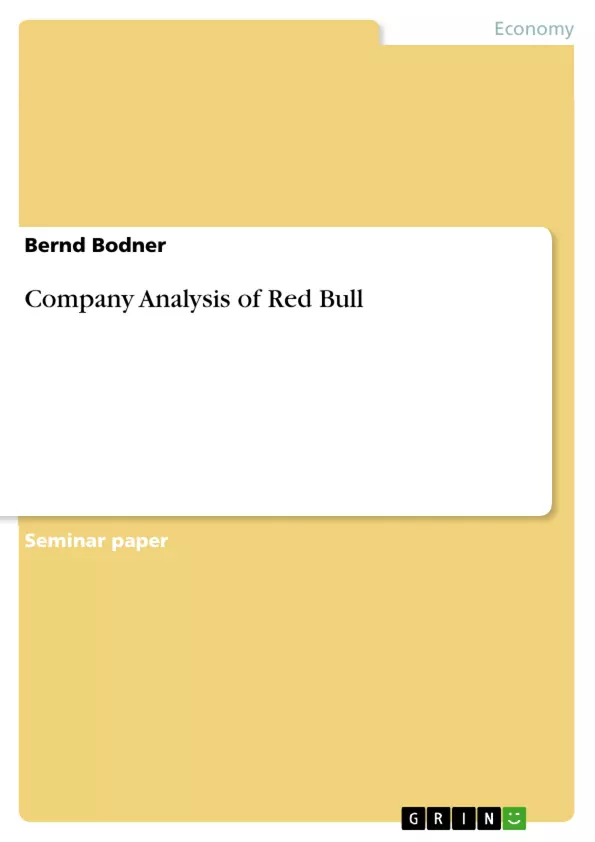"Red Bull gives you wings!" Nearly nobody never heard this slogan in his life or saw it somewhere or at least tried a sip of Red Bull. The Austrian company polarizes: Its taste, its marketing or the supposed health harming ingredients in this drink.
Red Bull is the world’s leading manufacturer of energy drinks through its Red Bull brand. Its energy drink is exclusively produced in Austria and consumed in more than 100 countries worldwide - throughout Europe and many parts of North and South America, Africa and Australia. (Datamonitor, 2004)
The drink made the founder of the company Dietrich Mateschitz to the 2nd richest Austrian and the number 208 in the world. (Forbes, 2010)
This paper will have a look on a short history of the company of Red Bull and the core sources of innovation. Secondly it will try to identify and discuss the individual skillset of Red Bull.
Furthermore it will go on with the writers analysis of the company and end with the external factors which the company must react on in the future. This section will also address the writers recommendations to the management of the company.
Inhaltsverzeichnis (Table of Contents)
- Introduction
- The History of Red Bull
- Red Bull's core sources of innovation.
- Individual skill set of Red Bull.
- Company analysis of Red Bull
- Strengths
- Market leadership
- Brand value.
- Weaknesses
- 4 products........
- Making their own enemies..\li>
- Opportunities.
- Expansion
- Innovation of new products.
- Threats...
- High marketing expenses.....
- Additional accidents of sport stars.
- Strengths
- External Factors & Recommendations
Zielsetzung und Themenschwerpunkte (Objectives and Key Themes)
This paper examines the history and innovative marketing strategies of Red Bull, a leading energy drink company. It explores the company's core sources of innovation, individual skill set, and analyzes its strengths, weaknesses, opportunities, and threats. The paper concludes with an analysis of external factors and recommendations for the company's future. The key themes explored in this paper include:- The history of Red Bull and its evolution from a Thai tonic to a global brand.
- The core sources of Red Bull's innovation, particularly its unconventional marketing strategies.
- The company's strengths, weaknesses, opportunities, and threats in the market.
- The role of sports sponsorship in Red Bull's marketing success.
- External factors and recommendations for the company's future.
Zusammenfassung der Kapitel (Chapter Summaries)
The first chapter provides an introduction to Red Bull, outlining its global reach and the company's founder, Dietrich Mateschitz. The chapter also discusses the unique taste of the drink and its polarizing effect on consumers. The second chapter delves into the history of Red Bull, tracing its origins to the Thai tonic "KratingDaeng" and its subsequent development into a global energy drink brand. The chapter details the marketing strategy employed by Mateschitz and the company's initial expansion into Austria and neighboring countries. The third chapter examines Red Bull's core sources of innovation. This includes the company's unconventional marketing approach, known as "buzz marketing" or "guerrilla marketing," which utilizes a range of tactics, such as free samples, product placement, and sports sponsorship. The chapter also highlights Red Bull's focus on extreme sports and its partnerships with high-profile athletes.Schlüsselwörter (Keywords)
Red Bull, energy drink, marketing, innovation, brand, buzz marketing, guerrilla marketing, sports sponsorship, extreme sports, company analysis, SWOT analysis, external factors, recommendations.- Quote paper
- Bernd Bodner (Author), 2010, Company Analysis of Red Bull, Munich, GRIN Verlag, https://www.grin.com/document/170396



